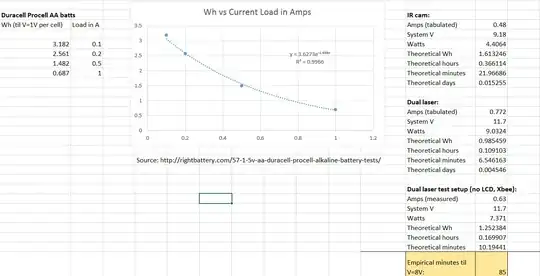I'm doing something wrong mathematically. Can anyone spot my mistake?
I'm powering some laser sensors and an arduino with 8 AA batteries and a step-up box for the lasers. I calculated a theoretical battery life using some empirical Watt-hour findings for my batteries here: http://rightbattery.com/57-1-5v-aa-duracell-procell-alkaline-battery-tests/
Both I and the source website used a cutoff point of 1V per cell. My cutoff point was 8V.
I first used their Wh values and plotted them out as in the attached image. Then I found an exponential approximation, input a measured current draw, and got an answer for my theoretical Wh (see bottom right of image under "Dual laser test setup (no LCD, Xbee)".
Then I divided the Wh by Watts, which is the measured system voltage times the measured current and got 0.169 hours which is 10 minutes. I ran a test though, and it took 85 minutes to reach 8V, starting from 11.7 with 8 batteries. There seems to be some discrepancy.
The batteries lasted 8 times longer than predicted! But I was under the impression that for batteries in series, you don't add the mAh, since the current through each battery is the same, as described here: Adding mAh when wiring battery cells in series?
So what gives?
